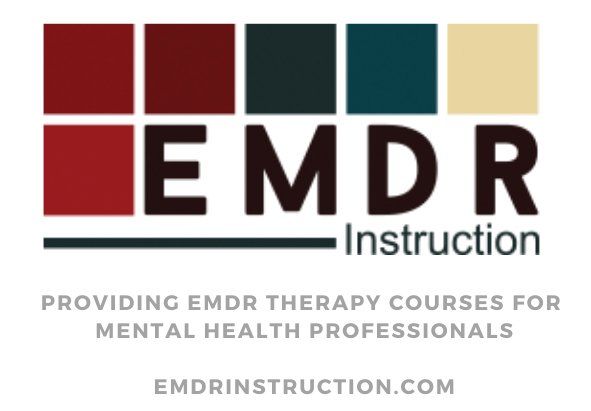An Overview of Our EMDR Training Program
An Overview of Our EMDR Training Program
This course has been approved by the EMDR International Association (EMDRIA). This is important as there are courses being offered which do not meet the credentialing established by EMDRIA. Consequently, those courses do not teach what has been determined to be necessary for the student to master EMDR. EMDRIA-approved courses are located on EMDRIA’s website. Go to emdria.org and look under training and certification.
In addition, when taking an EMDRIA-approved course, you are eligible to receive consultation from an approved consultant. You will also be able to work toward certification in EMDR and attend specialized training and conferences. Without an EMDRIA-approved course, you will not be eligible for these benefits. However, what is most important is that you learn EMDR in a way that will help you utilize it properly and effectively. Consequently, you will have more success with your clients which is the most important learning objective.
Students may be concerned about remembering all that is taught in the 3-day courses. The manual that you will receive as part of the course has been written in such a way that it will guide you step-by-step through each phase of the EMDR Training Course.
All students are required to obtain the textbook "Eye Movement Desensitization and Reprocessing: Basic Principles, Protocols, and Procedures," by Francine Shapiro, Ph.D. For Part 1, chapters 1–8 should have been read before the training. For Part 2, chapters 9–11 should have been read.
The course manual will be sent electronically upon completion of registration and payment.
Basic Training Hours
This course is taught in 2 parts. Students will complete 50 hours of education while learning EMDR.
Part 1 consists of 10 hours of lecture, 10 hours of supervised practice exercises, and 5 hours of consultation. Part 2 consists of the same number of hours for a total of 50 hours.

Basic Training Hours
This course is taught in 2 parts. Students will complete 50 hours of education while learning EMDR.
Part 1 consists of 10 hours of lecture, 10 hours of supervised practice exercises, and 5 hours of consultation. Part 2 consists of the same number of hours for a total of 50 hours.

EMDR Training Part 1
Part 1 Course Objectives
- The student will be able to use EMDR as a form of psychotherapy for simple cases of trauma. This means cases of simple PTSD, mood, or anxiety disorders. The first part of this course does not cover working with complex cases of trauma such as clients with extensive histories of abuse or dissociative disorders.
- The student will be able to describe and understand the adaptive information processing model (AIP) and its relevance to EMDR.
- The student will be able to know and understand what the components of a memory are as it relates to EMDR.
- The student will know and be able to describe the 8 phases of EMDR therapy.
- The student will be able to know and understand the basics of current EMDR research and its clinical relevance.
- The student will be able to know and utilize the criteria for the selection of an EMDR client.
- The student will know how to gather a history and develop an EMDR treatment plan for noncomplex cases. (See objective 1 on the limitations or Part 1 training).
- The student will know how to use EMDR in a responsible manner. Meaning he/she will be able to properly prepare a client for EMDR therapy and conduct a session properly while maintaining client safety at all times.
- The student will be able to explain EMDR to clients and prepare them for treatment.
- The student will have confidence that he/she can use EMDR in their practice.
- The student will have gained new skills and can use them in their practice immediately.
Part 1 Outline
The goal of the first part is to familiarize the client with the basics of the EMDR procedural steps and protocol. Through this instruction, the student will obtain the necessary knowledge and skills to begin the use of EMDR in his/her practice.
Day 1
- Introduction to the Origins and Development of EMDR.
- Instruction on the Adaptive Information Processing (AIP) Model
- Instruction on Phase 1: History of EMDR & Phase 2: Client Preparation
- Practice exercise in developing the skills for History Taking in Client Preparation.
- Approximately 4-Hours’ Lecture and 3-Hours’ Practice Training Exercises.
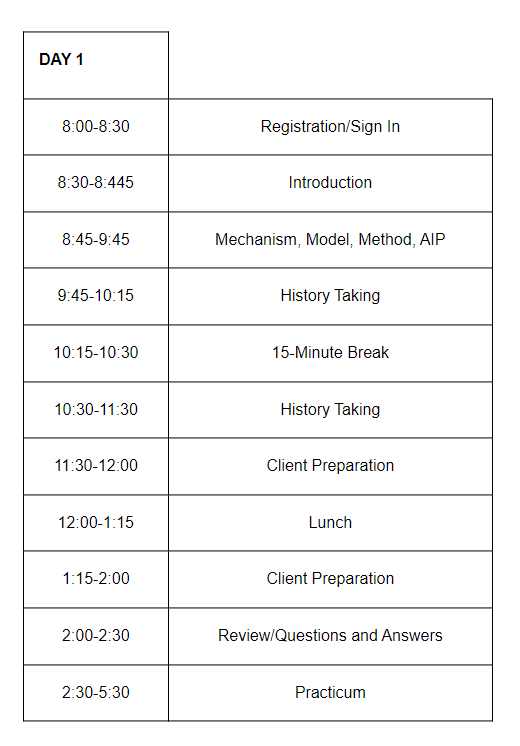
Day 2
- Complete instruction on Phases 3-7: Assessment, Desensitization, Installation, Body Scan, & Closure.
- Practice exercises with Processing a Memory with Phases 3–7. Approximately 3.5 Hours
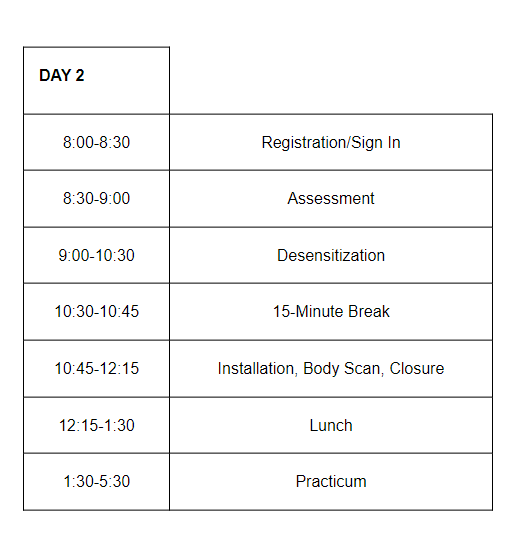
Day 3
- Instruction on managing processing, processing current triggers, and future concerns, the protocol for the future template, EMDR with children, as well as the protocol for recent traumatic events, and additional containment skills. Approximately 3.5 Hours
- Practice exercises re-evaluation of processed memory, processing additional relevant memories, current triggers, and future templates. Approximately 3.5 Hours.
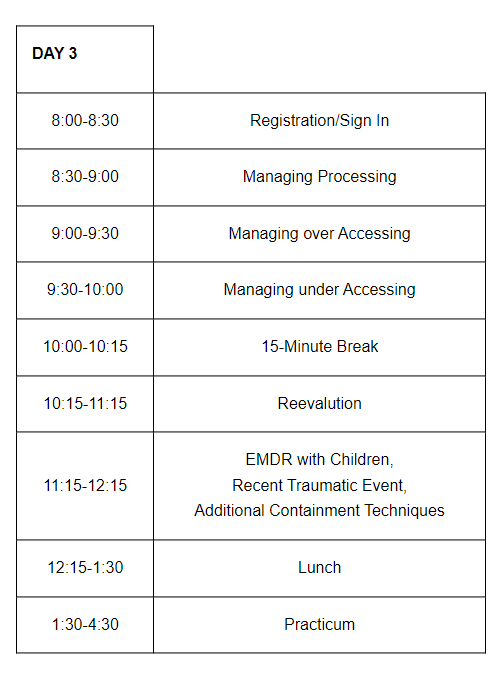
EMDR Training Part 2
Part 2 Course Objectives
- The student will be able to use EMDR as a form of psychotherapy for more complex cases of trauma. This means cases of complex PTSD, mood, or anxiety disorders. The first part of this course does not cover working with complex cases of trauma such as clients with extensive histories of abuse or dissociative disorders.
Note: completion of Part 2 of this course does not qualify a student to treat dissociative disorders if they have not had experience and training in treating them before taking this course. There is a difference between a dissociative symptom which is part of the traumatic experience and a dissociative disorder. - The student will have a complete understanding of the adaptive information processing model (AIP) and its relevance to EMDR.

EMDR Training Part 2
Part 2 Course Objectives
- The student will be able to use EMDR as a form of psychotherapy for more complex cases of trauma. This means cases of complex PTSD, mood, or anxiety disorders. The first part of this course does not cover working with complex cases of trauma such as clients with extensive histories of abuse or dissociative disorders.
Note: completion of Part 2 of this course does not qualify a student to treat dissociative disorders if they have not had experience and training in treating them before taking this course. There is a difference between a dissociative symptom which is part of the traumatic experience and a dissociative disorder. - The student will have a complete understanding of the adaptive information processing model (AIP) and its relevance to EMDR.

- The student will have a complete understanding of the 8 phases of EMDR therapy.
- The student will have a complete understanding of the criteria for the selection of an EMDR client. They will know what client is a good candidate for EMDR and which clients may be at risk during trauma therapy and may need more preparation.
- The student will have a thorough understanding of how to gather a history and develop an EMDR treatment plan for complex cases.
- The student will know the difference between treating PTSD and treating trauma.
- The student will be able to use EMDR in a responsible manner by utilizing the procedures of EMDR as taught and maintaining client safety at all times.
- The student will be able to explain EMDR to clients and prepare them for treatment.
- The student will have confidence that they can use EMDR in their practice with the disorders in which they have the experience to treat.
- The student will have a thorough understanding of the cognitive interweave and can incorporate this into their EMDR sessions.
Part 2 Outline
The goal of the second part is to review the basic EMDR protocols and procedures taught in Part 1. In addition, the second part will develop methods of treating more complex cases. This includes the development of treatment plans for complex cases, dynamics of trauma, and use of the cognitive interweave.
Day 1
- Review of the 8 EMDR phases, AIP, and the 3 stages of treatment past, present, and future.
- History taking, phase 1, with complex cases as well as client preparation.
- Resource Development and Installation (RDI). Lecture approximately 4 hours.
- Practice exercises taking history, client preparation, and RDI. Approximately 3 hours.
- Approximately 4-Hours’ Lecture and 3-Hours’ Practice Training Exercises.
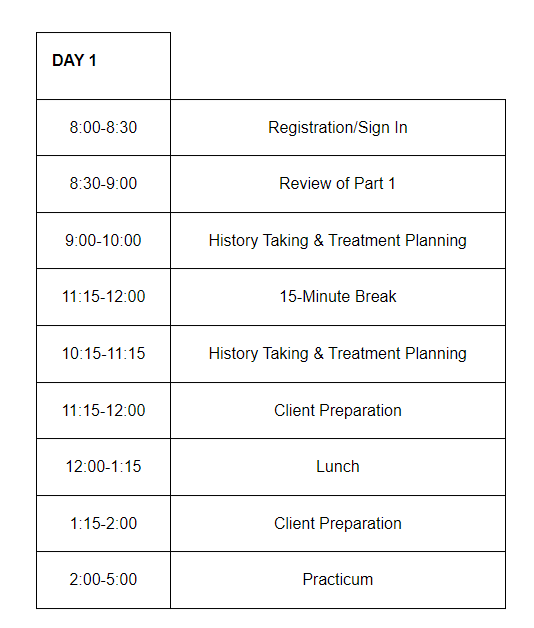
Day 2
- Use of phases 3–8 with more complex presentations and managing abreactions as well as over and under accessing during desensitization.
- Instructions on the cognitive interweave. Lecture approximately 3.5 hours.
- Practice exercises with processing a memory using phases 3–7. Exercises approximately 4 hours.

Day 3
- Instruction on obstacles related to processing, dissociation, treating specific situations such as phobias, illness and somatic disorders, self-use of eye movements, grief, adults abused as children and sexual abuse, couples, and combat and first responders. Approximately 3.5 hours.
- Practice exercises for completing EMDR treatment plan: past, present, and future. Approximately 3.5 hours.
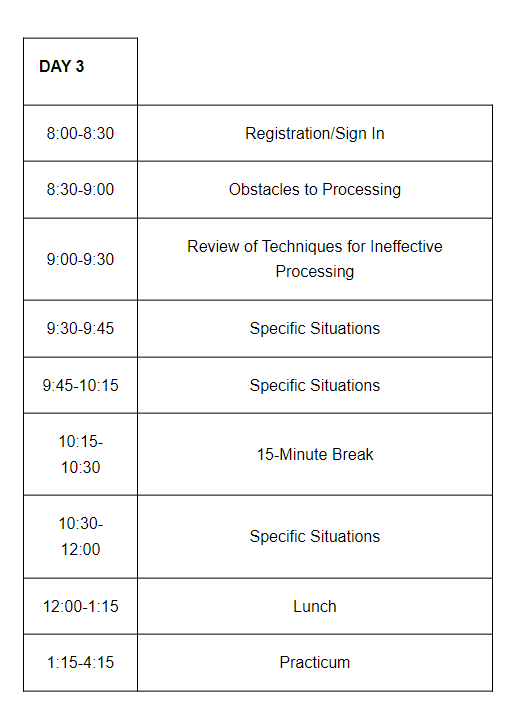
Steps to Get Started
01. Check Eligibility
Check to see if you meet the minimum requirements for our EMDR Therapy Training Courses at EMDR Instruction.
02. Register
Reserve your Course Registration for our Upcoming EMDR Training Course at EMDR Instruction by clicking here.
03. Pay
Once you have completed your Course Registrations, you will be redirected to make your Course Payments for Part 1 and Part 2 of the EMDR Training Courses.
Steps to Get Started
01. Check Eligibility
Check to see if you meet the minimum requirements for our EMDR Therapy Training Courses at EMDR Instruction.
02. Register
Reserve your Course Registration for our Upcoming EMDR Training Course at EMDR Instruction by clicking here.
Pay
Once you have completed your Course Registrations, you will be redirected to make your Course Payments for Part 1 and Part 2 of the EMDR Training Courses.
CONTACT INFORMATION
Phone: (318) 834-0969
Email: billwhiteks@gmail.com
Other Email: info@emdrinstruction.com
BUSINESS HOURS
- Mon - Thu
- -
- Fri - Sun
- Closed
Office Hours: Closed Major Holidays
The times above are office hours for clients and are not really relevant to the course dates.
PAYMENT METHODS
Uses CE-Go for payments

Contact Us
We will get back to you as soon as possible.
Please try again later.
CONTACT INFORMATION
Phone: (318) 834-0969
Email: billwhiteks@gmail.com
Other Email: info@emdrinstruction.com
BUSINESS HOURS
- Mon - Thu
- -
- Fri - Sun
- Closed
Office Hours: Closed Major Holidays
The times above are office hours for clients and are not really relevant to the course dates.
PAYMENT METHODS
Uses CE-Go for payments

Contact Us
We will get back to you as soon as possible.
Please try again later.
CONTACT INFORMATION
Phone: (318) 834-0969
Email: billwhiteks@gmail.com
Other Email: info@emdrinstruction.com
BUSINESS HOURS
- Mon - Thu
- -
- Fri - Sun
- Closed
Office Hours: Closed Major Holidays
The times above are office hours for clients and do not pertain to the course dates.
PAYMENT METHODS
Use CE-Go for payments

Contact Us
We will get back to you as soon as possible.
Please try again later.
